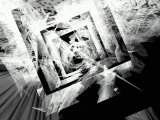|
1 |
|
work timeline |
|
„"A
bite is a combination of 8 bits. Each bit contains either a 0 or
a 1, so that is has either one of two possible states. Each of
the two digits stands for a tetrad (also: a nybble) of a byte,
i.e. 4 bits. 1 tetrad is enough to represent any number."
The Tetrad is a conventional idea in the natural sciences. It must be imagined processually as a coiled rotation. For this reason, the tetrad is highly suitable for spatializing the theories intended to "depict" a self-organizing system. As soon as a system begins to modify that from which it has emerged, as soon as it organizes itself, the unambiguous cause-effect relationship becomes a confusing cycle, in which the beginning is not only the beginning, but also a derived, subsequent entity, beginning and result, multiply allocated, without orientation, coiled, twisted, altogether complex. The situation represented here also describes the framework conditions for dealing with non-linear software tools, as in the case of the nybble engine project. nybble engineering An aesthetic message is usually the deconstruction of a conventionalized text form or a media text. It is recoded by destroying semantic portions in order to increase the aesthetic information. Nybble engineering applies this method at a basal level. This is less a matter of the interrelationship between semantic and aesthetic information, than the interrelation between uninterpreted and interpreted programs. To better understand this, let us look at an example from biology. The notion of a living cell as an automaton, a machine, has come to be taken entirely for granted in scientific thinking today. So-called replicases, for example, corresponding to a duplication apparatus, use programs in two ways. In terms of molecular genetics, a distinction is made between transcription and translation. In one case it is a command resulting in a sequence of activities: the program manipulates the machine. In the other case, as an object it is passively subjected to the routines: the program is manipulated by the machine. Thus when the program is uninterpreted, it is merely raw material for the duplication. When it is interpreted, on the other hand, the program controls this duplication. On the one hand, the behavior of any machine can be formally described with a list of transition rules, and on the other hand, any list of this kind can also be understood as a potential machine. First of all, nybble engineering needs existing material, to which the engineering can be applied. In the case at hand, this is real-time tools, such as so-called first-person shooter games, which represent a technical, artistic challenge with both their 3D surfaces and their replicating program components. Structurally, nybble engine movies (NEMs) are real-time network-movies, AV-products resulting from nybble engineering. NEMs are based on certain program configurations that process, when they are executed, between interpreted and non-interpreted components, and are calculated on the respective human/machine interface (PC) in real time. The NEM is an interactive program, the course of which can be influenced by players and bots equally; it can be used as a multiplayer environment. The nybble engine thus stands for both the entire program framework and the action bots in their function as replicating program elements. A NEM show a demo run through non-linear program architecture, a kind of digital road movie. Our understanding of the term machine is oriented to its current state of differentiation and must always be considered in conjunction with the term coupling. Norbert Wiener introduced this term with his ground-breaking work on cybernetics, published in 1948, and it is a formalism that makes it possible to link previously incompatible orders of the micro and macro level. Since then, the term coupling has grown tremendously in complexity and differentiation with Second Order Cybernetics, General Systems Theory and Radical Constructivism. When the tetrad is considered within the given framework of structural coupling, it is logical that the various generative factors, which are based not only on biogenic but also on technical programs, have an impact in socio-technical ensembles, starting at the program level, for instance action bots, game engines, authorship of the machine, continuing at the level of specific social contexts, as in the case of the "modular lecture", which is executed in the interrelations of different media levels. |
nybble-engine-movie stills |
|
| >>> data-objectile |








